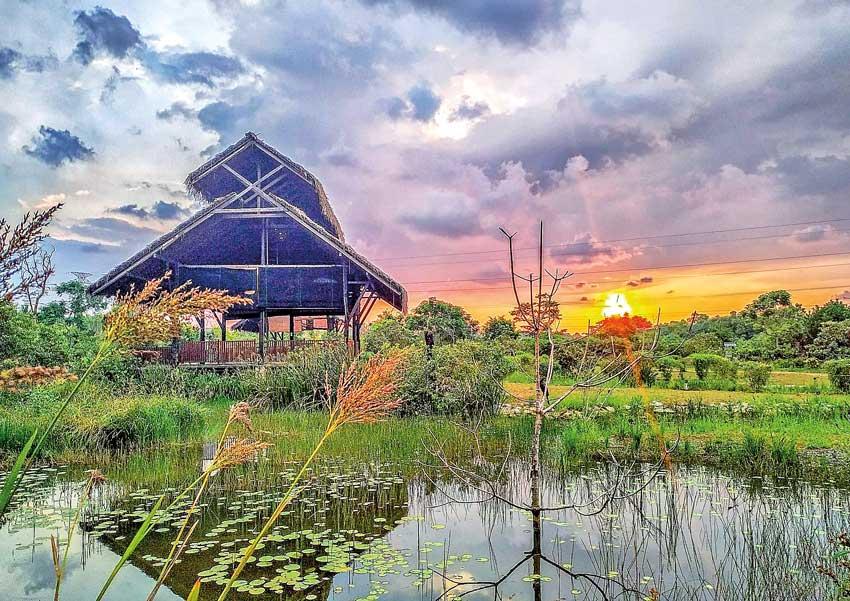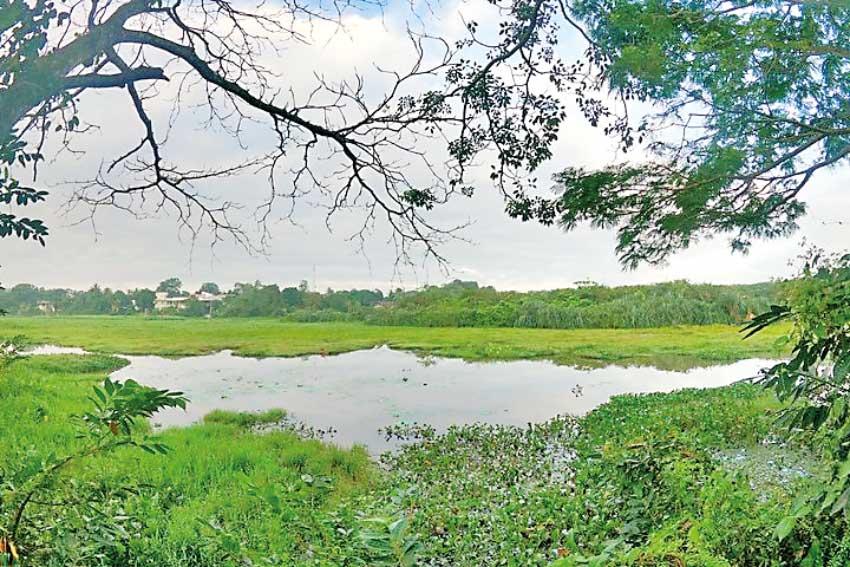Reply To:
Name - Reply Comment
Last Updated : 2024-05-17 14:10:00

Diyasuru Wetland - Certain segments in the society have started filling up wetlands and destroying these rich biodiversity hotspots
 A verse from the Salalihini Sandeshaya reads as follows ;
A verse from the Salalihini Sandeshaya reads as follows ;
With it’s red lotuses and golden swans,
Lake Diyavannā seems ever like a silk garb,
Worn by Lady Jayavaddana:
Its swirling stream as her waist-fold,
And the continuous ripples the garb’s pleats …
Here, the poet subtly describes the beauty of the Diyavanna Lake that enriches the Diyavanna Oya wetland ecosystem-which is one of many wetlands in Colombo today. Apart from Salalihini Sandeshaya, penned by Totagamuwe Sri Rahula Thera, several other Message Poems mention about the uniqueness of Sri Lanka’s wetlands, highlighting native species that grew in them before water hyacinths took over. Today, while certain segments in society have started filling up wetlands and destroying these rich biodiversity hotspots, environmentalists and communities living around these wetlands are struggling to protect the last remaining wetlands in Colombo and Sri Lanka.
 Thalangama Wetland
Thalangama Wetland
Wetland types in Sri Lanka
During the recently concluded lecture organised by the Wildlife and Nature Protection Society, on the topic ‘Action to Protect Wetland’ Prof. Siril Wijesundara of National Institute of Fundamental Studies, Kandy shed light on different wetlands habitats found in Sri Lanka. “Wetlands comprise characteristic vegetation of aquatic plants and are adapted to unique anoxic hydric soils. While most plants don’t survive in stagnant water, these plants survive because they grow on water and this is a remarkable factor of these special plants. According to the Asian Wetland Directory there are 41 international sites of importance in Sri Lanka covering 274,000 hectares in total,” said Prof. Wijesundara.
Even though many assume Muthurajawela to be the only Wetland in the country wetlands in Sri Lanka are divided into three broad categories. “These include inland freshwater wetlands such as rivers, streams, marshes and swamp forests. Then there are salt water wetlands such as lagoons, estuaries, mangroves, sea grass beds and coral reefs. Apart from that man-made wetlands include tanks, reservoirs, rice fields and salterns,” he added.

The Namal Pokuna Temple ruins draw links to the Yakkure Tribe that lived in the citadel back then. The secret behind it is simple. It was the freshwater that comes from streams that enabled people to create such a thriving civilization on a rocky outcrop
Prof. Sevvandi Jayakody
“Sri Lanka also has an extensive network of rivers and streams most of which originate from the Central Highlands and all these rivers cover about 4500 kilometres. What is important is that these rivers have riverine vegetation on both sides which are unique. Apart from riverine vegetation in the dry zone there are interesting riverine plants in the wet zone as well. There’s a genus called Hortonia which has three species and are stream-side plants. Crudia zeylanica is a controversial tree that gained much popularity during the construction of the central highway. This too is a wetland species that grow by streams, similarly to kumbuk. As such these trees are adapted to wetland conditions.
Then there are villus covering around 12,500 hectares. Many of them are found in the Mahaweli flood plains in the East and also at the Wilpattu National Park. There are plants that are unique to these villus. For example, Fimbristylis zeylanica is a plant that is only found in the villus of Wilpattu. It cannot be found anywhere else in the world and is critically endangered.
He then shed light on freshwater marshes and explained that these are shallow inland depressions located mainly in rural areas either connected to a river or receiving water through surface run-off, river flood water and ground water seepage. “The Muthurajawela Marsh falls into this category and is the biggest peat bog in Sri Lanka. The freshwater swamp forest is a late successional stage of freshwater marsh ecosystems comprising of trees that are adapted to grow in shallow stagnant water. The most interesting swamp forest in Sri Lanka is the Walauwewatta Wathurana swamp forest located in the Kalu River basin which spans across 12 hectares of land,” said Prof. Wijesundara.
He showed several flora that are unique to this unique habitat including species in the Hora family. Another plant called Suwanda which is in the same genus as the National tree and is survived by six mature trees at this swamp forest and it is believed to be the only remaining trees in the world in a natural population. There are some plants in the botanical gardens, but they’re cultivated.
Prof. Wijesundara also shed light on montane bogs or swamps located in wet patana grasslands in areas such as Horton plains and the Handapan Ella plains, estuaries and mangrove habitats, saltwater and brackish water coastal wetlands, coral reefs and sea greats beds than could be found along the coastline of Sri Lanka.
Then there are man-made tanks and reservoirs. In Sri Lanka there are nearly 10,000 tanks and reservoirs and these account for approximately 4.6% of the surface land area. Newly built reservoirs such as Victoria, Rantambe, Lakshapana are now considered wetlands.
Ecosystem services provided by wetlands are manifold. Since they are in low-lying areas there will be greater consequences if they are filled. They help to mitigate floods, retain sediments, purify the water, remove toxic compounds, act as a carbon sink, provide breeding habitats for edible fish. According to the 2012 Red List, there are 370 plants species that can be termed aquatic. However 41% of these plants have been threatened. Researchers say during the 2020 Red List study the percentage of threatened plants has increased to 48%. As such, the 2020 Red List proved that all species of Cryptocoryne were threatened, eight out of ten species of Lagenandra were threatened and 14 out of 21 Eriocaulon species were threatened.
Connectivity of wetlands
In his presentation Prof Sampath Seneviratne, a Research Scientist, who is the Professor in Zoology, Department of Zoology and Environmental Sciences, University of Colombo, shed light on the relationship between birds and wetlands; especially migratory birds. “Colombo is a Ramsar Wetland city and is the only such city in South Asia. It’s a system of wetlands connected through water, animals and plants. Wetlands are dynamic and changing a lot. 40% of all species live or breed in wetlands and this is a remarkable number. In the tropical context there are few wetlands compared to other types of habitats. In wetlands you see a lot of animals. This diversity of life reflects in productivity and our uses. Less diversity in wetlands means less fish on our plate and less interesting meal. In Sri Lanka we depend on wetlands extensively for fish. However, over the past 100 or so years, the quality of food has been reducing as animals and humans eat smaller fish; earlier we used to eat carnivorous fish, but now we eat more planktonous fish,” said Prof Seneviratne.

The Muthurajawela Marsh falls into this category and is the biggest peat bog in Sri Lanka. The freshwater swamp forest is a late successional stage of freshwater marsh ecosystems comprising of trees that are adapted to grow in shallow stagnant water
Prof. Siril Wijesundara
Over a billion people make a living out of wetlands and this could be close to USD 47 trillion. “As such wetlands are important for human economy and the globe to function. Wetlands have a lot to do with connectivity. Coastal waters are considered wetlands and if you take connectivity of seawater it extends from Sri Lanka to India and beyond, thereby making inland wetlands connected to wetlands in other systems. The river systems that flows into the ocean travel in all directions from Sri Lanka makes it a Wetland country. These wetlands are connected not only from water. Studies from 2008 and 2019 shows that a satellite tagged Olive Ridley turtle moved from Bangladesh to East coast of India and then to Sri Lanka. Ten green turtles tagged in Rekawa moved along the southern coast and some to Mannar, Lakshadweep and West. A tagged leatherback turtle in Panama is currently moving into the Caribbean and it will soon reach Europe and down to Spanish Coast.
“Of that linkage birds are more prominent because around 2500 birds across the world move over long distances. These movements are facilitated through wetlands as they improve their productivity and act as refuelling and recharging stations for birds to migrate. During summer birds go there and during winter they move downwards and Sri Lanka is also one of their destinations. Sri Lanka is in the Central Asian flyway and through wetlands we are connected to the rest of the world.” The professor explained.
However, from a conservation point of view Prof. Senevirathne said that there’s no point in talking about conservation if a species is threatened daily. Wetlands are not wastelands; but only scientists and researchers are aware of this fact. At present, Mannar and surrounding areas have become potential locations for wind farms and other linear infrastructure development projects. But birds have adjusted themselves to windmills, but many birds fall prey to windmills due to differences in their visual fields and wing loading capacities. Some birds have a particular field of vision and therefore they do not see what is above them. Therefore some may not know until they have come closer to a wind blade.
He therefore suggested sensitivity mapping as a way to protect migratory and endemic birds from falling prey to development. “Britain has done it where they have maps of birds, butterflies and other species. This will help researchers identify the landscape according to the risk levels and declare no-go zones and green zones. Such alternatives need to be looked at if we’re moving towards Green energy.
“Roads are the second biggest biodiversity killer and the road network has increased by six folds over the past one and a half decades. He said that encroachment, polluting marine habitats and hunting practices have challenged coexistence to a greater extent. Therefore there needs to be more action, commitment and a little bit of intelligence if we’re to move forward in a sustainable manner,” he said in his concluding remarks.
Wetlands and man
Prof. Sevvandi Jayakody, Senior Lecturer in Environmental Science at the Wayamba University, placed special emphasis on how wetlands have been at the core of ancient civilizations . “One doesn’t expect to discover a civilization that thrived in the rocky and arid Dimbulagala mountains. But the Namal Pokuna Temple ruins draw links to the Yakkure Tribe that lived in the citadel back then. The secret behind it is simple. It was the freshwater that comes from streams that enabled people to create such a thriving civilization on a rocky outcrop. As such, wetlands create civilizations. Whether it’s a river, stream or a manmade reservoir, these unique habitats have helped us to live.
 Wetlands have a lot to do with connectivity. Coastal waters are considered wetlands and if you take connectivity of seawater it extends from Sri Lanka to India and beyond, thereby making inland wetlands connected to wetlands in other systems. The river systems that flows into the ocean travel in all directions from Sri Lanka makes it a Wetland country
Wetlands have a lot to do with connectivity. Coastal waters are considered wetlands and if you take connectivity of seawater it extends from Sri Lanka to India and beyond, thereby making inland wetlands connected to wetlands in other systems. The river systems that flows into the ocean travel in all directions from Sri Lanka makes it a Wetland country
Prof Sampath Seneviratne
“Therefore rivers and wetlands connect us,” she continued. “There are different cultures and people living along different gradients of a river. But in most instances we are cheating mankind. Every time you eat a pot of curd you don’t think about the mud that is being used to make curd pots. Sometimes we wonder if it’s a sustainable industry itself. There are communities that have lived for thousands of years and along Maha Oya we see people moving out. There are abandoned clay pits along the river and as a result these clay pits have become breeding grounds for mosquitoes. They also break connectivity with wetlands. Our relationship with wetlands is not only with natural wetlands but with man-made wetlands as well. Therefore whether it’s a seasonal or a perennial reservoir that is 2000-3000 years old, along with that we have created a civilization,” Prof. Jayakody.
She further stressed on how man has destroyed what connects them, thereby causing severe challenges in terms of coexistence. Activities such as illegal sand mining, haphazard dumping of waste, impacts on fisheries communities are just a few.
She therefore proposed several ways in which wetlands could present opportunities for people as well as ways in which people could ensure a future for wetlands. These include everything from inter-sectoral linkages to strategic environmental assessments, a river continuum approach for development, establishing the Polluter Pays Principle, application of valuation to decision-making, hiring staff to monitor and analyze big data with regards to wetlands, taking the power of protecting sensitive areas more seriously and self-auditing oneself and reconsidering your contribution to protect wetlands and the environment.
Arnold Thursday, 24 February 2022 07:40 AM
What wetlands? Whole of Sri Lanka is on the verge of being offered in a platter to India, China and others in return for rice, sugar, parippu, etc.
Ranaweera Thursday, 24 February 2022 09:14 PM
Those who talk about these wetlands are doing so to get some funds from NGOs to get them a comfortable life. They have no love for the wetlands. These wetlands should be converted into big lakes to avoid these becoming dengue breeding grounds and shelter for Kassippu makers.
Gert Jan, the Netherlands Friday, 25 February 2022 04:48 PM
The problem is that the MP that holds the portfolio in Sri Lanka does not have a clue about watermanagement. My excellent Srilankan collegues in Sri Lanka ( trained in the Netherlands where watermanagement is core business) are completely disregarded. Soon the Dutch financial assistance will stop because of this.

Add comment
Comments will be edited (grammar, spelling and slang) and authorized at the discretion of Daily Mirror online. The website also has the right not to publish selected comments.
Reply To:
Name - Reply Comment
The state-run loss-making State Mortgage & Investment Bank (SMIB) has reveale
US authorities are currently reviewing the manifest of every cargo aboard MV
On March 26, a couple arriving from Thailand was arrested with 88 live animal
According to villagers from Naula-Moragolla out of 105 families 80 can afford

4 hours ago